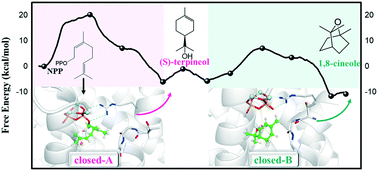Insights into the enzymatic catalytic mechanism of bCinS: the importance of protein conformational change†
Abstract
Although the available crystal structures of bCinS (Streptomyces clavuligerus 1,8-cineole synthase), a typical class I terpene cyclase (TPC), have shown notable protein conformational flexibility once bound with a substrate, the catalytic mechanism and the roles of protein conformational change are still unknown. Herein, we performed elaborate multiscale simulations to explore the detailed enzyme catalytic mechanism. The protein conformational change of the conserved kink region during catalytic processes and the ligand flexibility play important roles in regulating the catalytic selectivity of bCinS. Meanwhile, the importance of fleeting chiral intermediates is also discussed. Finally, the whole enzymatic cycle was concluded and the key structural factors (Mg2+ cations, R174 and G178) responsible for the active pocket conformational transformation from the “closed-A” to “closed-B” state were revealed. As a representative instance of enzymatic catalysis coupled with important protein conformational changes, it guides us to paying more attention on the potent catalytic roles of protein conformational change in other class I TPCs.



 Please wait while we load your content...
Please wait while we load your content...